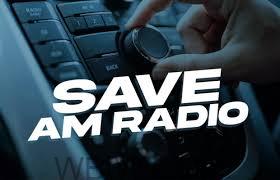
WASHINGTON— During a Tuesday House subcommittee hearing, lawmakers considered a proposal to require an AM radio to be included in every vehicle sold.

“AM radio has been delivering for consumers for 100 years right now, and last year, over 85 million Americans listened to AM radio,” said Rep. Jan Schakowsky (D-IL).

Faced with growing bipartisan support for Congress stepping in to address some carmakers’ move to yank AM radios out of their dashboards, the Alliance for Automotive Innovation, which represents the auto industry, offered its first concessions.
Alliance President John Bozzella told the subcommittee that automakers are willing to “disclose very conspicuously” if a model does not have AM radio. “You’re not going to see a lot of those except on electric cars,” he said. Bozzella said automakers are also willing to provide hand crank AM radios as part of the standard emergency kits they sell with vehicles.

“I think AM radio is important,” Bozzella said. “I’m a big listener of AM radio and we’re not about taking it away.”
But Melody Spann Cooper, CEO of Midway Broadcasting, said keeping hand-crank radios in the trunk is not the same as keeping AM in the dashboard.

“That’s just not feasible when people are in an emergency,” she said. Cooper pointed out that while some people get alerts today from mobile devices, those messages often simply direct Americans to turn on the radio.
“For them to sound an alarm and send it to your local broadcaster further supports our premise that AM radio is important in times of emergencies,” Cooper said. It is the most foolproof operation that you can have, and it is the backbone of the emergency system.”
She said local broadcasters provide live, local, and regional information for days and weeks after a disaster.
The focus of the hearing is the proposed AM Radio for Every Vehicle Act (H.R. 4313). The bill last month secured a majority of House members saying they back the effort, drawing on the support from lawmakers in both political parties. To date, 247 members of the House on both sides of the aisle have come out in favor of the proposal.
If passed, the bill would require the Department of Transportation to issue a rule that requires all new motor vehicles to have AM radio as standard equipment. If they don’t, carmakers could be fined.
Before the rule’s effective date, manufacturers that do not include AM would be required to put a warning label on vehicles. The GAO will also be used to study and report on whether a reliable alternative communication system exists for delivering emergency alerts.
Rep. Gus Bilirakis (R-FL) said the issue is “very vital” to emergency alerts, especially in a hurricane-prone state like Florida. “Alerts need to go to the largest portion of the affected population feasible,” he said, noting radio reaches 91% of Americans each week, according to Nielsen. “This is where AM radio can become so important and will continue to be in the future,” Bilirakis said.

Even as some electric vehicles have dropped AM, Bozzella believes it will remain available in the U.S. for decades regardless of what Congress does. He said there are about 286 million light-duty vehicles on U.S. roads, and even if every automaker discontinued AM today, it would take more than 30 years for AM to phase out.
“There is no pressing need for immediate government action, and Congress has time to fully study this issue and understand where analog AM radio fits into the government’s overall emergency alert protocols,” Bozzella pleaded.
What Cost Safety?
The auto industry claims keeping AM radios in cars will cost as much as $3.8 billion, although it was unable to say what that would amount to per vehicle. While some lawmakers expressed concerns about having new costs passed onto consumers, Rep. Kelly Armstong (R-ND) argued that they are no different from the costs associated with other safety features—and in rural North Dakota, radio may be the only way alerts reach people.

“I don’t particularly care how much it costs,” Armstrong said. “I’m all for whatever is the best way to communicate.”
Bozzella said automakers are committed to making AM/FM radio and streaming services available for free.
“There’ll be no need for a subscription to hear an emergency broadcast,” he pledged.
He added there is likely to be a “gradual increase” in the number of vehicles without AM if Congress doesn’t step in.
Rep. Debbie Dingell (D-MI), whose Detroit district is the center of the U.S. car industry, urged her fellow lawmakers to tap the brakes.

“I’m an AM radio fan, so I think studying the question is important,” Dingell said. “I wouldn’t first mandate a particular technology and then study it. I think would be preemptive to consider a fall mandate.”

Rep. Cathy McMorris Rodgers (R-WA) said while she’s no fan of government mandates, carmakers are leaving them no choice. “We’re at a moment where Congress’ hand is being forced to intervene. And corporations are choosing not to do what’s in the best interest of the American people,” she said.
‘Staunch Support For Preserving AM’
While much of the hearing was focused on emergency alerts, Navajo Nation Executive Director Justin Ahasteen said their KTNN Window Rock, AZ (660) does more than that. It also connects a sprawling Native Nation in the rural Southwest where some don’t speak English, and many don’t have access to mobile signals.

“If vehicles that are available on the market don’t have AM radio within them, we’re setting our people up for failure and potentially causing a public safety crisis,” Ashasteen said.
If Congress were to pass the bill, Consumer Technology Association President Gary Shapiro thinks it would put one medium ahead of every other. He said CTA has a long-standing committee with the National Association of Broadcasters that looks for ways to improve technical specifications to improve radio receivers. However, while they have come up with recommendations, they have never been implemented, and AM has suffered as its technical problems mounted. “The mandate in this area is dangerous,” adding that it will harm competition globally in EVs.
Yet Ford began offering car owners a software update to bring back AM. No other brand has done the same, however.
Bozzella explained that while it is easy for one brand to reverse course, it may not be as easy for another.
“Not every manufacturer has the same platforms, the same technology arrays, and the same approaches to designing vehicles,” he said, pointing to variables like battery systems and shielding.
NAB has been heavily lobbying on behalf of the bill, and Tuesday’s hearing was an essential step in seeing legislation advance in the House. “America’s broadcasters are grateful to the subcommittee members and other lawmakers who have voiced staunch support for preserving AM radio in cars,” NAB President Curtis LeGeyt said. “It’s a lifeline in emergencies and the backbone of the Emergency Alert System.”
Meanwhile, in the Senate, the number of senators supporting the bill grew to 60 on Tuesday, leading supporters to call for a vote in the chamber. The 60-vote super-majority means there is enough support to overcome any opposition.
Information: INSIDERADIO.








.png)











